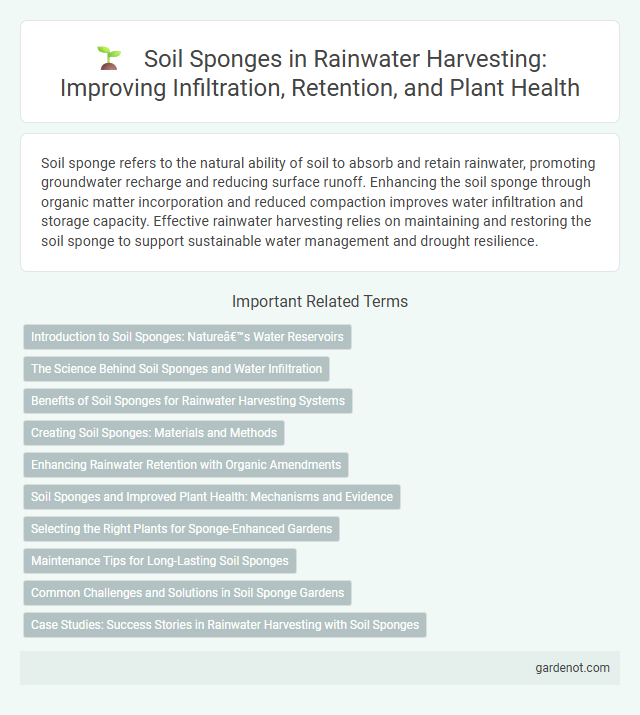Soil sponge refers to the natural ability of soil to absorb and retain rainwater, promoting groundwater recharge and reducing surface runoff. Enhancing the soil sponge through organic matter incorporation and reduced compaction improves water infiltration and storage capacity. Effective rainwater harvesting relies on maintaining and restoring the soil sponge to support sustainable water management and drought resilience.
Introduction to Soil Sponges: Nature’s Water Reservoirs
Soil sponges act as natural reservoirs by absorbing and storing rainwater within their porous structure, enhancing groundwater recharge and reducing surface runoff. Comprised of organic matter and soil particles, they increase soil permeability and moisture retention crucial for sustainable rainwater harvesting. Improving soil sponge capacity helps mitigate drought impacts and supports agricultural productivity by maintaining consistent soil hydration levels.
The Science Behind Soil Sponges and Water Infiltration
Soil sponges consist of porous soil structures that efficiently absorb and retain rainwater, enhancing water infiltration and storage in the ground. Soil texture, organic matter, and pore size distribution determine the soil sponge's capacity to capture rainwater and reduce surface runoff. This natural absorption process supports groundwater recharge, mitigates erosion, and sustains plant growth during dry periods.
Benefits of Soil Sponges for Rainwater Harvesting Systems
Soil sponges enhance rainwater harvesting systems by increasing soil porosity and water retention capacity, which reduces runoff and promotes groundwater recharge. They improve soil health through better aeration and nutrient absorption, supporting plant growth and reducing erosion. Incorporating soil sponges in rainwater harvesting designs leads to more efficient water use and sustainable landscape management.
Creating Soil Sponges: Materials and Methods
Creating soil sponges involves incorporating organic materials such as compost, biochar, and mulch to enhance soil structure and water retention capacity. Techniques like sheet mulching, no-till farming, and cover cropping increase porosity and improve infiltration rates by promoting microbial activity and aggregating soil particles. These methods collectively optimize rainwater harvesting by maximizing soil moisture storage and reducing runoff.
Enhancing Rainwater Retention with Organic Amendments
Soil sponge refers to the soil's enhanced capacity to absorb and retain rainwater, which can be significantly improved by incorporating organic amendments such as compost, biochar, and mulch. These organic materials increase soil porosity, promote microbial activity, and boost water infiltration rates, effectively reducing surface runoff and erosion. Enhancing soil sponge properties optimizes groundwater recharge and supports sustainable rainwater harvesting practices in agricultural and urban landscapes.
Soil Sponges and Improved Plant Health: Mechanisms and Evidence
Soil sponges, composed of organic matter and micro-porous soil structures, enhance rainwater retention and improve water infiltration, directly supporting plant hydration and nutrient uptake. Improved soil porosity reduces erosion and runoff, maintaining moisture availability during dry periods, which promotes root growth and overall plant resilience. Empirical studies demonstrate that landscapes with effective soil sponges show higher crop yields and healthier vegetation due to sustained soil moisture and enhanced microbial activity.
Selecting the Right Plants for Sponge-Enhanced Gardens
Choosing plants with deep root systems and high water absorption capacity maximizes the effectiveness of soil sponges in rainwater harvesting gardens. Native species such as switchgrass, prairie coneflower, and black-eyed Susan promote soil aeration and enhance moisture retention. Incorporating drought-tolerant perennials and groundcovers improves infiltration rates and reduces runoff, creating resilient, sponge-enhanced landscapes.
Maintenance Tips for Long-Lasting Soil Sponges
Regularly inspect soil sponges to prevent clogging from debris and sediment, ensuring optimal water absorption. Incorporate organic matter such as compost to maintain soil porosity and enhance sponge durability. Avoid compacting the soil by limiting heavy foot traffic, preserving the sponge's structure and effectiveness in rainwater harvesting.
Common Challenges and Solutions in Soil Sponge Gardens
Soil sponge gardens often face challenges such as soil compaction, poor infiltration, and microbial imbalances that reduce water retention and plant health. Implementing solutions like incorporating organic matter, applying mulch layers, and utilizing cover crops enhances soil structure and promotes microbial diversity. Regular monitoring and adaptive management optimize water absorption and mitigate common issues in rainwater harvesting systems.
Case Studies: Success Stories in Rainwater Harvesting with Soil Sponges
Case studies of rainwater harvesting using soil sponges demonstrate significant improvements in groundwater recharge and agricultural productivity, particularly in semi-arid regions like Rajasthan, India. Implementation of soil sponge techniques increased soil moisture retention by up to 40%, reducing irrigation needs and enhancing crop yields such as millet and pulses. Projects in Kenya's arid zones also reported decreased surface runoff and improved drought resilience for small-scale farmers, validating soil sponges as effective tools for sustainable water management.
Soil sponge Infographic

 gardenot.com
gardenot.com